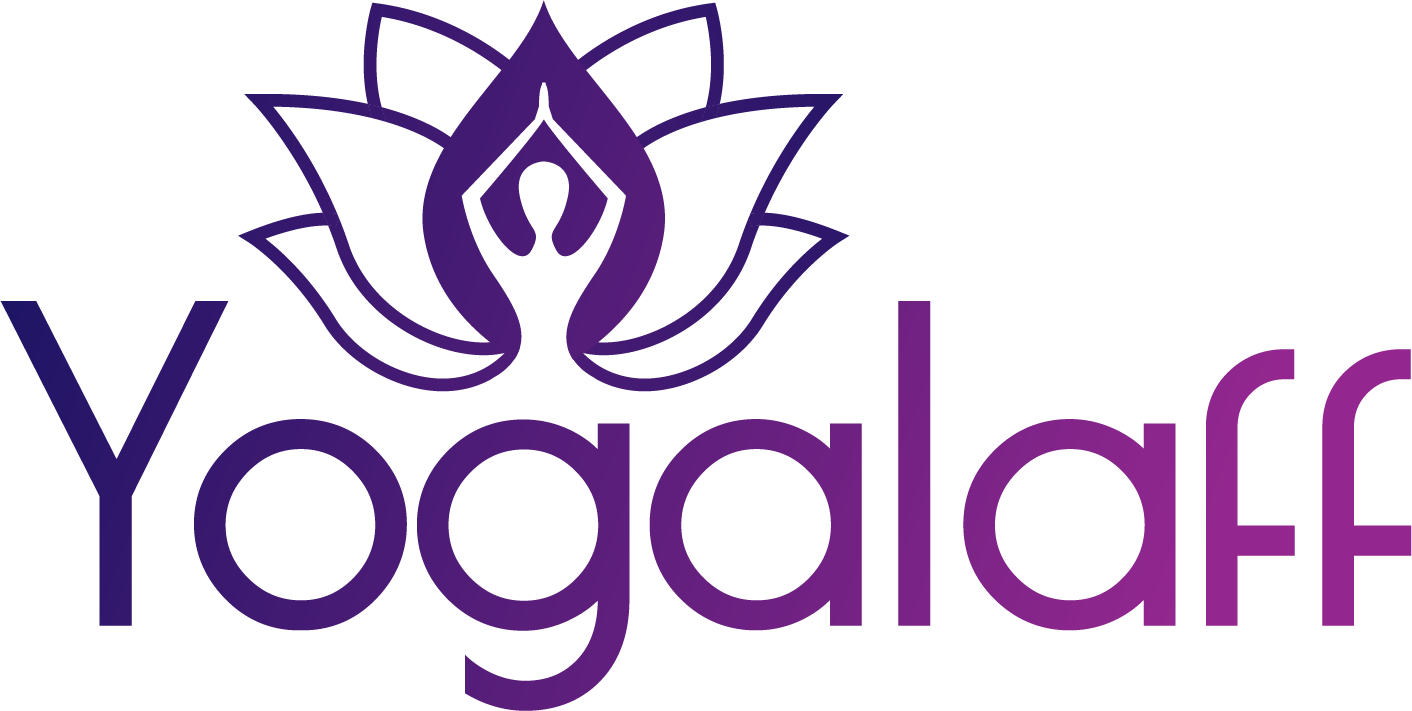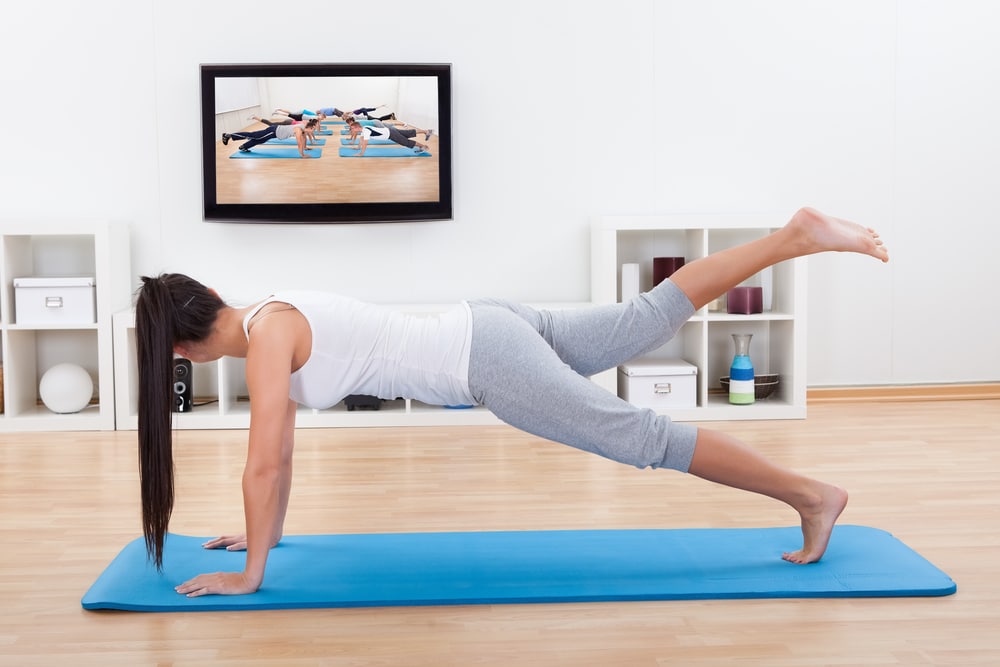 Yoga is a practice. Just like anything we choose to pursue, we all have to start somewhere. As you begin to learn and practice the art of yoga at home, you will find that you grow spiritually, mentally, and of course physically.
Yoga is a practice. Just like anything we choose to pursue, we all have to start somewhere. As you begin to learn and practice the art of yoga at home, you will find that you grow spiritually, mentally, and of course physically.
Yoga is just as much about physical exercise as it is mental relaxation and release. The art of yoga has been practiced for over 5,000 years. It was first used as a development of the spirit while training the physical body. Typical practice increased self-awareness, consciousness, and the ability to be grounded at the moment.
Some people approach yoga because of its low-impact characteristics and the ability to be easy on the joints of your body, some pursue yoga for more of a spiritual enlightenment. Whichever reason you have chosen to learn yoga, in this article you will learn more about what you need to get started and achieve success as you begin your practice.
Types of Yoga
There are various types of yoga and each one has its own benefits for the body, mind, and spirit. Listed below are 3 of the most popular types of yoga.
These variations range in intensity from restorative gentle yoga to extreme fat-burning. Choosing the type of yoga you would like to practice is something that you should consider carefully concerning your current health status and recommendations from a medical professional.
-
Vinyasa
Vinyasa (pronounced “vin-yah-sah”) is the most popular type of yoga. The word “flow” is often paired with this practice and it is most-known for the emphasis on achieving fluidity between poses with smooth transitions. In addition, there is an importance placed on the linkage of the breath with the movements.
-
Bikram
Bikram (pronounced “bick-rahm”) is also known as “hot yoga”. It is named after its creator, Bikram Choudhury. This practice takes place in a room heated to 35-42 C (95-108 F) and with a high humidity level. The heat level is said to increase blood flow throughout the body, creating positive changes when paired with controlled breathing. It’s also known to help increase self-image due to the mental barriers one must break through to continue exercise in the heated environment.
-
Restorative
Restorative yoga is a type of practice that focuses on slowing down the body and mind, emphasizing deep muscle relaxation and stretching. This is a very supported practice, using the floor, wall, and other objects to help maintain stability and ease within the movements. This is the least energetic of the practices and deeply promotes restoration within the body and mind.
What Do I Need?
In order to practice yoga, you’ll need a few things to make sure you’re safe and educated since you’ll be doing this on your own at home. It’s easy to do alone, but it’s important to have the basics so that you’re set up to succeed.
I will suggest the necessary items, but I will also include other items that can make your practice more enjoyable as you advance.
Yoga Mat
A yoga mat, which is available in different sizes, is a rubberized soft material that provides grip to avoid slipping during an exercise routine.
The mat comes in various thicknesses depending on the level of support you prefer in your workout. The yoga mat is a great way to make the practice yours by choosing fun colors, shapes, and patterns.
Link to Shop: Yoga Mats on Amazon
Comfortable Clothing
It’s important when you begin to practice yoga that you dress in clothing that promotes a good range of motion, flexibility, and cooling properties.
There are various poses where significant arm, leg, or torso movement is required and that will be much more enjoyable if you are wearing clothing with flexible waistbands, loose sleeves, and restriction-free qualities.
You can also purchase socks which are specially created to have additional grip on the soles to increase support as you’re beginning the practice.
Link to Shop: Yoga Tops on Amazon, Yoga Bottoms on Amazon, Yoga Socks on Amazon
DVD’s or Youtube
Yoga is typically a full body activity and requires knowledge of correct form, postures, and breathing. This is the most difficult part if you’re learning on your own, but that is why it’s important to find a great coach who can support you in learning the foundations of yoga.
Adriene has content going over the basics of yoga. In this video, she focuses on specific, common poses as well as beginner sequences and instructional support.
If you would prefer to have something that doesn’t require an internet connection, there are numerous DVDs available that you can play at home or while traveling to places where the internet may not be readily available.
According to Amazon, The Gaiam Beginner’s Yoga DVD Kit, includes 9 practices on three full-length Gaiam DVDs from a variety of acclaimed yoga instructors: Patricia Walden, Rod Stryker, Suzanne Deason and Rodney Yee. It also includes a 40-page printed yoga guide and 8 pose cards. There is a bonus 30-day free subscription to My Yoga Online included in the purchase as well.
Mat Cleaning Spray (Optional)
If you plan to partake in Bikram Yoga, you will be working out and increasing body heat in your body which leads to sweating! When we sweat, our body gets rid of many different types of waste and toxins that we have been holding on to.
After a session, it’s common to roll up your mat and toss it into your car until the next session where that waste as a chance to multiply. Before you roll it up, it’s a great idea to spray some natural yoga mat cleaner.
This product naturally combats odor-causing fungus, bacteria, and grime. This isn’t required for yoga practice, but it can be helpful to keep you healthy.
Yoga Blocks (Optional)
These blocks are made from light, high-density foam that can function well for a complete beginner or advanced practice yogi.
These blocks aid in increasing flexibility, bringing the ground a little closer to you. They’re not required to begin your practice but they can be a good tool to have in your box for the future as you grow.
Shop here: Yoga Blocks
Poses for Beginners
Now that you are all prepared to begin the yoga practice, there are a few poses that you will continually come across as they are the foundation of yoga as a whole.
Remember, yoga originates in the Sanskrit, but each of the original pose names now has an English counterpart. You won’t have to memorize them unless you’re planning to become a yoga instructor someday, but they are nice to recognize and are quite fun to say.
Mountain Pose (Tadasana)
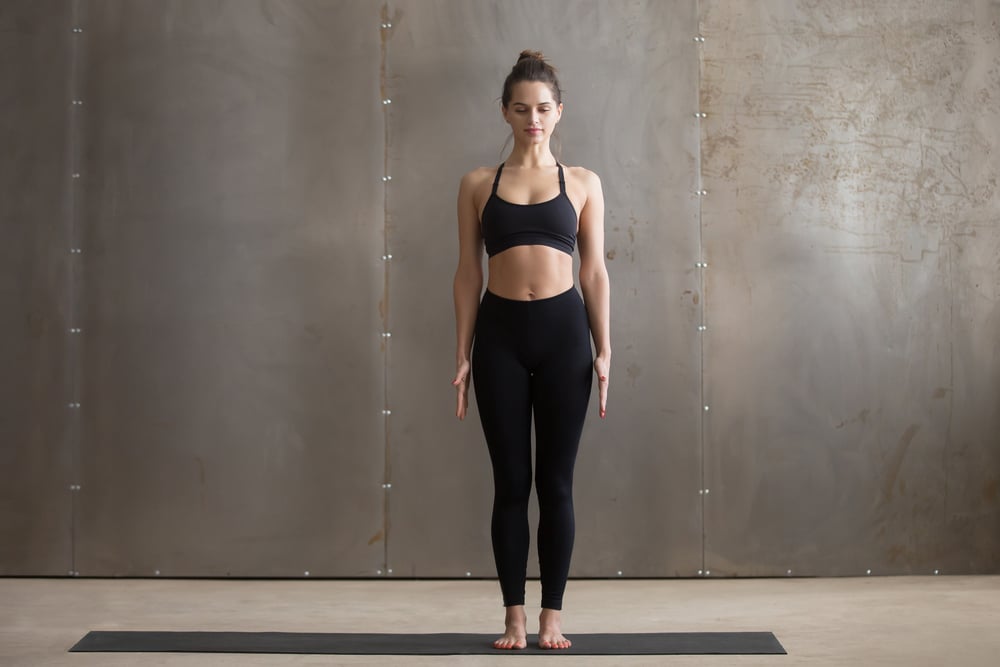 Mountain pose?
Mountain pose?
This looks like standing!
It is standing, but there are a few key characteristics that come into the mountain pose. While you’re here, focus primarily on alignment.
This pose is physically simple. Mentally, you should be focusing on your intention for the practice such as, “Alignment” or “Support” and bringing your mind to a place of calm.
Starting with your feet, align the heels behind your toes. Evenly balance your weight between both feet, not favoring one side or the other. Begin to “ground” down by tightening the upper thigh muscles, core, and back.
Open your chest and lift it upwards, grounding through the back of your body and opening through the front. Pay close attention to the neck, spine, and back; make sure to align them one over the other as if they are connected by a board, unable to work without each other.
Downward-Facing Dog (Adho Mukha Svanasana)
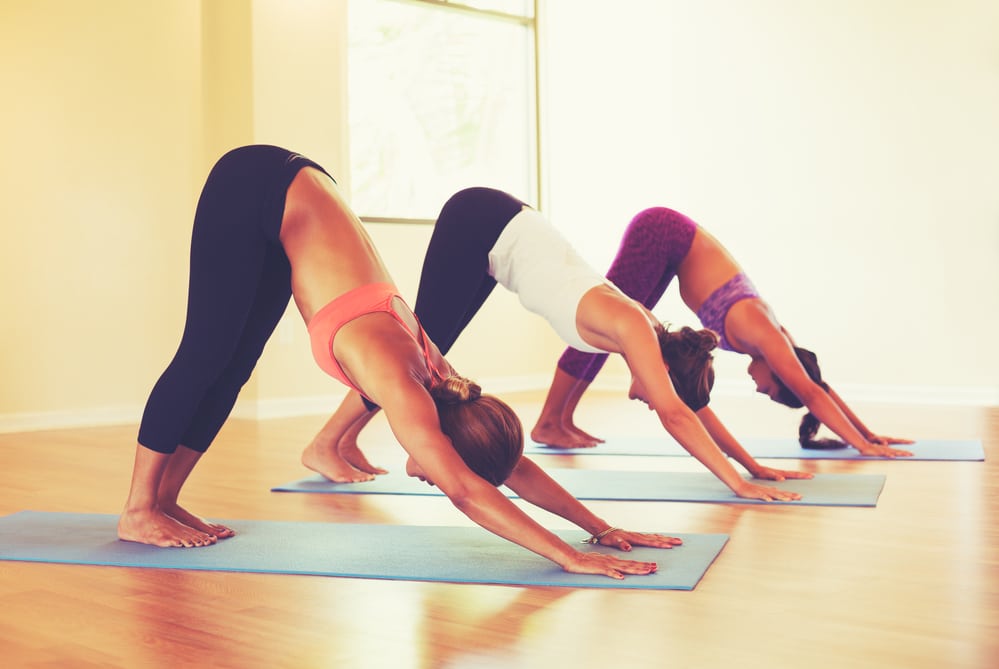 The “downward dog” is a common, highly recognized pose in yoga. It works as a strength builder but an overall rejuvenating stretch.
The “downward dog” is a common, highly recognized pose in yoga. It works as a strength builder but an overall rejuvenating stretch.
It may be difficult when you first attempt it, but as you practice and your muscles grow this becomes the resting pose for your practice.
Begin the pose on your hands and knees, carefully aligning the spine. Place your knees directly below your hips and your hands directly below your shoulders.
Spread your hands and evenly distribute the weight amongst your fingers. Be sure not to collapse your shoulders into your arms but to maintain integrity in your spine, chest, and core.
Exhale. Push your hips upwards. Keep your knees bent and lift your heels off the floor. Press your tailbone high and push your upper thighs against your belly, drawing the energy upwards towards the tailbone.
Stretch your heels towards the floor. It is okay if you’re unable to touch them, you will learn as time goes on. Do not lock your knees but begin to slightly straighten them. Straighten your arms and maintain the alignment of your spine as your shoulder muscles carry most of the weight from this pose.
Child’s Pose (Balasana)
 This pose is considered a mid-routine relaxation pose when you need to catch your breath or relax your arms. This is a perfectly good pose to default back to during a session that becomes difficult as you are beginning to learn.
This pose is considered a mid-routine relaxation pose when you need to catch your breath or relax your arms. This is a perfectly good pose to default back to during a session that becomes difficult as you are beginning to learn.
Sit on your feet with your knees and chins touching the floor. Touch your two big toes together, separate your knees so that they are in line with your hip bones.
Exhale deeply and allow your chest and torso to relax between your upper legs. Allow your back to arch and relax your head allowing it to rest gently on the ground as your neck and cervical spine stretch.
Reach your arms out long, not forcing them to reach but extending them until they are at their natural resting position. You can stay in child’s pose for as long as you would like, continuing to situate and move around until you can achieve maximum relaxation.
Remember to breathe slowly and deeply in this pose as you recover from more fatiguing poses.
Upward-Facing Dog (Urdhva Mukha Svanasana)
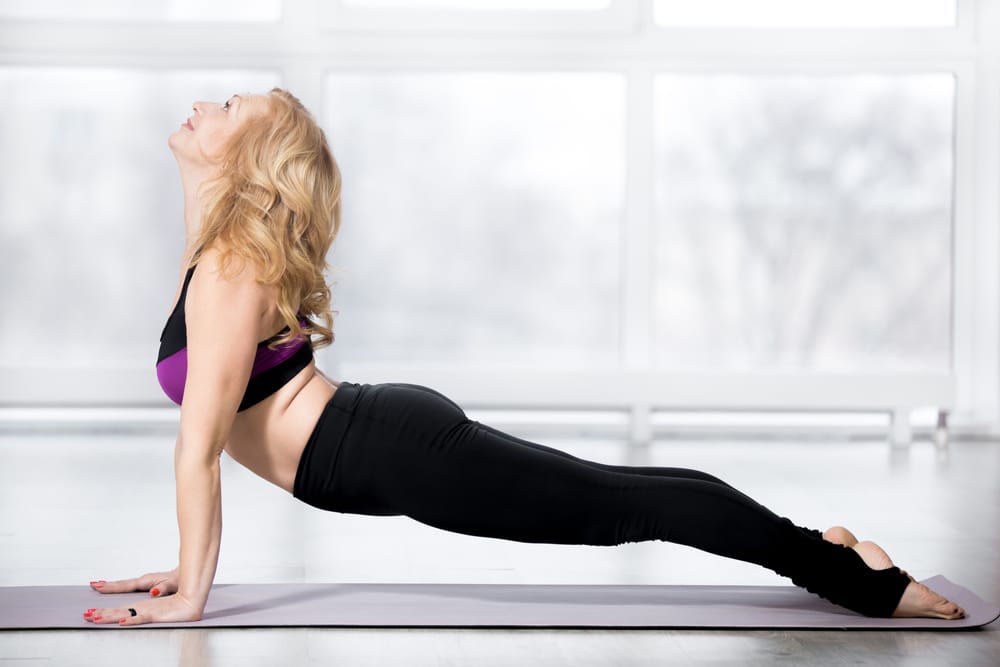 This pose creates an “open heart” which is a term you will begin to hear a lot in yoga. You will start by laying on the floor, on your belly.
This pose creates an “open heart” which is a term you will begin to hear a lot in yoga. You will start by laying on the floor, on your belly.
Reach your legs back and stretch them away from you. Place your palms in line with your waist and secure the evenly distributed weight as you did in Downward-Facing Dog.
Inhale deeply and press firmly into your entire hand as you being to straighten your arms and lift your hip bones off of the ground. Rotate your arms slightly so they are plugged into the floor.
Tighten your core and buttocks. Squeeze your shoulder blades and open up your chest, lifting your sternum upwards towards the ceiling. Keep your head and neck relaxed.
You can lift your shins off the ground if you are feeling strong, but for a beginner, it is perfectly okay to leave the bottom portion of your legs touching the ground as extra support. Breathe easily and hold for 15-30 seconds.
Corpse Pose (Shavasana)
 The corpse pose is the pinnacle of yoga relaxation! When you are at the end of your practice, this is the best pose to slip into while you deeply breathe and allow your muscles to recover.
The corpse pose is the pinnacle of yoga relaxation! When you are at the end of your practice, this is the best pose to slip into while you deeply breathe and allow your muscles to recover.
Sit here for 30 seconds or 5 minutes, there aren’t many rules to the corpse pose except to completely relax.
Slowly make your way to your back. Your goal here is to place the body in a neutral alignment, not forcing your knees or arms to be straight. As you lie down, begin to take inventory of your body starting at your toes.
Completely relax and allow yourself to sink into the ground, reminding yourself of its entire support, knowing that you don’t have to put any effort forth to keep your body stable.
Relax your hands to your sides, facing your palms upwards. It’s okay to add a slight pillow or blanket under your neck or behind your lower back for additional support if you are feeling any pain or discomfort.
Allow your mind to drift into a mindful state as you recover from the practice. When leaving the corpse pose, stand up slowly to avoid any lightheadedness or dizziness.
Put it Together: At Home Yoga Routine
Now that you’ve learned the basics of yoga foundations including: types, history, clothing, supplies, and poses, it is time to put it all together to form a routine.
Included below is a video of a basic sun salutation routine which is the most well-known type of vinyasa yoga and its goal is to quickly promote “flow” or cultivate energy in the body. This routine is about 7 minutes long.
Yoga can be an excellent home exercise program to be used for physical, mental, and spiritual health.
While yoga seems difficult, there are many available resources for you to be able to learn to practice in the comfort of your own home. Through the resources in this article and your dedication, you can become a successful yogi in no time. Enjoy! Namaste.
